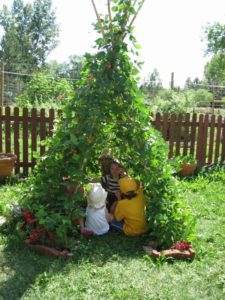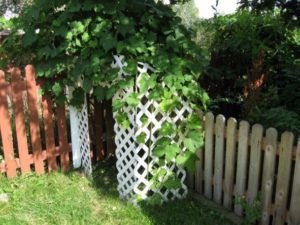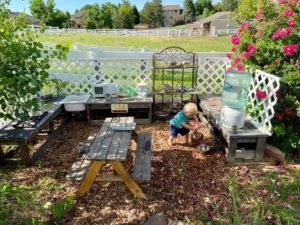Some passions can lie dormant for years, sleepily lifting their heads from time to time until they finally get the chance to explore, and be explored, more deeply. For me, gardening is one such passion. I’d had occasional veggie boxes, and planted flower bulbs here and there, but it wasn’t until I started working in early childhood and creating nature-based play spaces that my passion really blossomed. As a Waldorf child growing up in an urban-rural interface in the Midwest, I spent endless hours interacting with the natural world: pressing flowers, making crowns from leaves or dandelions, catching fireflies, crawdads and sunfish, creating caterpillar habitats, building miniature dams and canals in the creek. Now, living in Colorado, the attitude towards nature seems very different. Here, there is a distinct doctrine of “look, but don’t touch.” Nature is portrayed as something fragile, something that can be ruined if we touch it, handle it, walk on it. Indeed, we are told that we are ruining nature every time we turn on the news. But how are today’s children to develop a deep, abiding love for the natural world if they don’t get to be immersed in it?
After years of creating children’s play spaces at the margins, I was finally able to buy a home with some land and started creating my own Play Garden, where I now run outdoor parent-child classes for children ages 1-5. A garden is never actually finished, but six years later it is a place with so many flowers that I don’t care if the children pick them to make bouquets. It has so many fruits that we can stop and pick raspberries, look under leaves for strawberries, pull up carrots, and pop cherry tomatoes or grapes into our mouths as we walk by. It is fun and infinitely interesting for children, with water and sand and mud and swings and slides and lots of kid-sized spaces, but it feels much more like a garden than a playground. In it, I strive to create a space that is beautiful, relaxing and engaging all at the same time, for adults as well as children.
My goal today is to share some of my own sources of gardening inspiration, and to offer some approachable projects if you would like to create your own nature-filled spaces for children and adults to enjoy.
The Garden Awakening
During my first year of Play Garden classes, a visitor asked if my garden had been inspired by the book The Garden Awakening by Mary Reynolds. I immediately ordered it and read it cover-to-cover. In it, Reynolds writes about “re-wilding” our garden spaces, letting them be a bit less tame, less manicured, more like a forest or a meadow or a wonderful secret garden that you stumble across unexpectedly. She writes about the gardener and the land working together, the gardener listening to what the land wants and supporting it to be its best self, the self it longs to be. She writes about incorporating symbolism, meaning, and poetry into our hardscape and garden design. I found her own work to be really exciting, especially one garden that she designed completely around a poem. And unexpectedly she mentions Rudolf Steiner, with a hat-tip to biodynamic gardening.
This book completely changed my relationship with my garden. For one thing, I stopped pulling out all of the “volunteer” saplings that kept appearing in my garden beds, and instead just thinned some and let others grow. Ask me in five years if this was a good idea—right now it’s charming. There are willows and aspens and cottonwood saplings springing up along my dry creek and throughout my hilly areas. Next, I built a spiral path leading to a weeping cherry tree, and began making plans for it to expand into a triskele (a triple spiral, representing the birth/death/rebirth cycle). The center of it is a stepping-stone path across my dry creek that splits in the middle. Nobody will know that symbol is there, but I will, and my garden will. And around that time I discovered that a poem in which I had long loved one particular stanza, but other stanzas were strange and one completely bizarre, suddenly made perfect sense when I realized that it was not my poem, but my garden’s poem. My garden has a poem! I printed it out and taped it to my bathroom mirror. I don’t have room to share the poem here, but it is “For No Reason” by Hafiz. My garden and I began a newer, much deeper phase of our relationship with one another.
All this time, I was planting more and more flowers. I first attended, then started hosting gardening swaps where people happily dug up plants to share from their gardens, and I would end up with as many plants as I could get into the ground. I started flowers from seed, focusing especially on ones that I could sow directly into the soil. My blue flax, larkspur, columbines, California poppies, lupines, hollyhocks and black-eyed-Susans all wander around my gardens from year to year as their seeds spread, moving downhill or downwind or occasionally dying out. I knocked on strangers’ doors and asked if I could dig up some of their prolific lilies, or asters, or catmint—they all said yes. I found free and cheap yard furniture on Facebook Marketplace, a free playhouse on Craigslist that just needed some TLC, and I stashed away kitchen utensils for my future mud kitchen. I bought bags of shells from thrift stores and buried them in my sand play area for children to discover as they dug. I made a gathering space for puppet shows with mulch, stumps, and a shade sail overhead. Last year I got a pizza oven so we can bake outdoors, and in the fall I bravely decided to make fires in our fire pit for parents and children to roast apple slices with cinnamon as the weather got cold. The families loved it, and my Play Garden went from being fun to being truly magical.
If you’re starting to think about your own back yard, and how great it would be to have an abundant, beautiful, and interesting place to hang out, good! That’s what I want! We adults are the gatekeepers for children’s access to the outdoors, and the more we are outside, the more they will be outside too. Research is clear on the value of outdoor time for children: for their physical development, improved attention and academic performance, increased resilience and grit, and more. But it’s easy to forget that time outdoors is beneficial to us grownups, too. If you are lucky enough to own a yard that you can do with as you will, then I encourage you to make it into a place that you truly love. Will creating a play garden in your yard be work, and need maintenance? Well, yes, certainly some. However, so does grass. Most of my flowers come back year after year, and while gardens do need some weeding I’ve learned to make peace with bindweed and grass in the flower beds, dandelions in the lawn, and thistles hiding on the outskirts of everything. I keep some parts mowed and embrace the “re-wilding” my land to a certain extent.
Sources of Inspiration
So, how do you get going? How do you make a plan, and move from plan into action?
If you’d like some ongoing inspiration, I highly recommend joining LifeWays North America’s online class this fall, “Learning in Nature 2: The Mystery and Wonder of Exploring Nature with Children.” You can find it by going to their website https://lifewaysnorthamerica.org/ and clicking on “Upcoming Classes.”
If you want some immediate inspiration, you are welcome to peruse some or all of my many Pinterest boards: https://www.pinterest.com/joyfultoddlers/_saved/. If you prefer to hold something in your hands, a book I’ve returned to many times is A Child’s Garden: 60 Ideas to Make Any Garden Come Alive for Children by Molly Dannenmaier. A book I am currently reading is Natural Playscapes: Creating Outdoor Play Environments for the Soul by Rusty Keeler, and a book I’ve ordered but haven’t read yet is Creating a Family Garden: Magical Outdoor Spaces for All Age by Bunny Guinness. And of course, The Garden Awakening: Designs to Nurture Our Land and Ourselves by Mary Reynolds, but be aware that her book is text-heavy rather than image-heavy.
If you’re not much of a book person and you’d rather just get going, here are five projects to make your garden a little more magical. I’ve ranked them in order of ease, and I’ve included photos of them from my own gardens. You’ll notice that almost all of them involve inviting plants upward, off the ground; this creates a three-dimensional space where we can be surrounded by nature rather than just looking at it from above. Make changes for your space and your climate as needed.
Play Garden Projects
- A Bean Teepee

This project is inexpensive and simple. A dozen bamboo poles from a garden center, twine to tie them together at the top and make horizontal stripes to hold the structure together, and some beans to plant. I was nervous about my toddlers pulling up the sprouting bean plants, so I planted pretty flowers at the base that we practiced watering and smelling and touching just with one finger; by the time the beans were climbing, the toddlers were able to interact with the plants appropriately. Scarlet Runner beans are the easiest/best for coverage and have pretty red flowers, but any type of runner or pole bean will do; avoid bush beans. My favorite is to grow a combination of Scarlet Runners, Kentucky Wonder pole beans, and Yellow Wax pole beans. Children will eat all of them off the vine, and you can add them to your meals.
- Willow Archways

These may be even easier than the bean teepee, depending on where you live. Here in Colorado where it’s extremely dry, it took some effort. But even here a person can grow willow simply by cutting branches and soaking them in a 5-gallon bucket of water for a few weeks. Add fresh water as needed, and when the branches grow a good number of roots, dig a hole next to your archway and put them in. Water generously the first year; trim as frequently or infrequently as you wish. With some types—like weeping willows—the branches will meld together over time if they’re touching one another. Others—like the wild volunteer willow that I dug up—do not do that.
- A Trellis House

This project is also cheap and simple. It involved two 2’ x 8’ trellis panels from a home improvement store, one made of wood, and the other flexible plastic; a couple of garden stakes, and some zip ties. I chose a place where two fences met, and curved the flexible trellis into an arched shape. I supported it on the tall end with the garden stakes, which I attached using the zip ties. I cut the wooden trellis in half so each half was one foot wide, and used them to create a more rigid front of my very tiny playhouse; this was also attached using zip ties. I planted a grape vine next to it, which I trained over the trellis house and along the fence.
- A Mud Kitchen
 Mud kitchens can be as basic or as fancy as you want. I started with three outdoor benches and got a small sink and some gas stove burner covers from the Habitat for Humanity ReStore. Gradually I added the trellis walls, the little picnic table, and all of cooking accessories. The most important “ingredient” for your mud kitchen is water. I use a 5-gallon water dispenser so that if a child leaves it open, no more than five gallons will drain away. We refill the dispenser from the hose as needed.
Mud kitchens can be as basic or as fancy as you want. I started with three outdoor benches and got a small sink and some gas stove burner covers from the Habitat for Humanity ReStore. Gradually I added the trellis walls, the little picnic table, and all of cooking accessories. The most important “ingredient” for your mud kitchen is water. I use a 5-gallon water dispenser so that if a child leaves it open, no more than five gallons will drain away. We refill the dispenser from the hose as needed.
- An Outdoor Room
 This is potentially the most expensive and complex of the projects, but I strongly urge you to consider something along these lines. Do you remember what I said about adults being the gatekeepers to children’s access to the outdoors? Having a comfortable, shady, relaxing spot for adults to sit—close to the most active play areas—increases the time that we’re willing to spend outdoors with children who want or need us to be nearby. It’s also lovely as a restful spot for children to be with their adults. I turned my outdoor pergola into a “real” room by putting down an outdoor carpet (now I don’t have to mow under the furniture, and it doesn’t get muddy), installing a pull-down shade on the sunny side, and of course growing plants up the sides! I have concord grapes on one side and hops on the other. Hops grow to 30’ in length and will cover the pergola in a season, but they die back to the ground each winter, and they are also mildly invasive in some climates. Another nice covering vine option is Silver Lace Vine, which bears tiny white flowers that float down around you. My clematis won’t grow taller than about six feet, and my trumpet vine is beloved by wasps, so I’ve given up on them as covering vines for a seating area.
This is potentially the most expensive and complex of the projects, but I strongly urge you to consider something along these lines. Do you remember what I said about adults being the gatekeepers to children’s access to the outdoors? Having a comfortable, shady, relaxing spot for adults to sit—close to the most active play areas—increases the time that we’re willing to spend outdoors with children who want or need us to be nearby. It’s also lovely as a restful spot for children to be with their adults. I turned my outdoor pergola into a “real” room by putting down an outdoor carpet (now I don’t have to mow under the furniture, and it doesn’t get muddy), installing a pull-down shade on the sunny side, and of course growing plants up the sides! I have concord grapes on one side and hops on the other. Hops grow to 30’ in length and will cover the pergola in a season, but they die back to the ground each winter, and they are also mildly invasive in some climates. Another nice covering vine option is Silver Lace Vine, which bears tiny white flowers that float down around you. My clematis won’t grow taller than about six feet, and my trumpet vine is beloved by wasps, so I’ve given up on them as covering vines for a seating area.
The Takeaway
Children learn from what we do, not what we say. If we show them through our actions that being outdoors and interacting with nature is enjoyable, valuable, and worthwhile, then they will grow up with that as an expectation for their own lives. The fact that we get to enjoy the benefits along the way is even better. Enjoy your gardens!

Faith Collins is a teacher, speaker, and author of the book Joyful Toddlers and Preschoolers: Create A Life that You and Your Child Both Love. To see more photos of her Play Garden, visit https://www.joyfultoddlers.com/play-garden/.